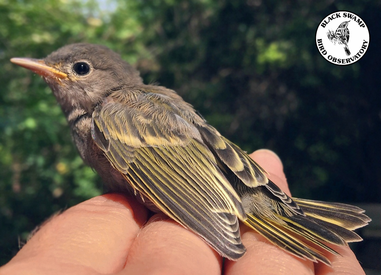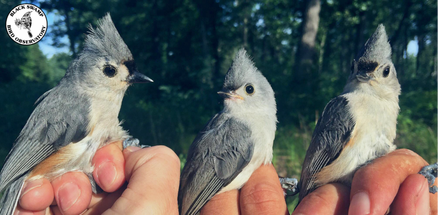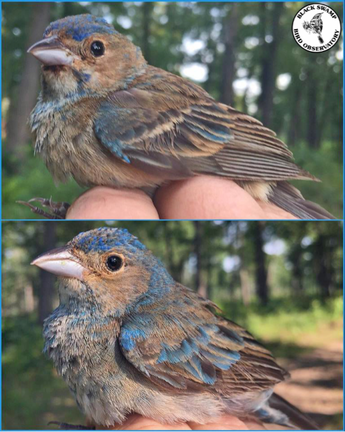Enjoying our blogs?Your support helps BSBO continue to develop and deliver educational content throughout the year.
|
|
As we continue to gather and analyze the data from this year's spring banding season, we've been hard at work operating two MAPS stations: One located in the restored oak/dogwood shrub-scrub habitat along the Gallagher trail behind the BSBO headquarters. And the second, in a portion of the Oak Openings Preserve Metropark that encompasses sand dune, oak forest, shrub-scrub, and degraded grassland habitats. We are about mid-way through the summer season and have encountered some great birds at both stations including American Woodcock, all the Yellow Warblers at BSBO, Cedar Waxwing, Summer Tanager, Ovenbird, and Lark Sparrow. This is such a great and unique time to work with birds - for a multitude of reasons - but chiefly: compared to migration, the return rate of breeding birds is much higher, allowing us to compare individuals from year to year and hone our aging and sexing skills; and both young and adult birds are molting, allowing us to document the patterns of species and the irregularities of individuals. While we would love to write something about each species (and sometimes each bird!) we encounter during the breeding season, there simply isn't enough time or available space on the server to allow for such lengthy posts. However, a few birds each session always tend to catch our eye.  This HY Yellow Warbler banded June 25th at BSBO, has recently left the nest and is still in nearly full juvenal plumage (or first-basic plumage). This first set of body feathers (not often seen in the field) is grown quickly after hatching, providing the young bird with just enough protection and camouflage while it remains in and near the nest. The quality of these feathers is quite low, giving the bird a matte and floofy appearance. After fledging, HY birds will quickly roll into their pre-formative molt, replacing their body feathers and some wing covert feathers (depending on the species). In the case of Yellow Warblers, HY birds will attain higher quality yellow body feathers in their pre-formative molt, giving them the distinct look of the species and separating their plumage as male or female. Because flight feathers are of heavier construction and require more energy to grow (compared to body feathers), many HY birds (including the majority of species of passerine) will retain their juvenal primaries, primary coverts, secondaries, and rectrices through the pre-formative molt, eventually replacing them during the pre-basic molt the following year.  Caught together at Oak Openings, this (presumed) family group of Tufted Titmouse represent three generations of birds. From left to right we have a third-year male TUTI, an HY TUTI (the presumed offspring), and a second-year female TUTI. Despite being quite similar in appearance, the HY bird is still in full juvenal plumage, showing loose, floofy body feathers, a yellow gape, and a pinkish bill base. Male and female TUTI are identical by plumage, and males will develop a brood patch, making it difficult to sex individual birds. Luckily, these birds were captured together and we were able to differentiate physical breeding signs between the two adult birds, separating them as male and female. Due to the nature of molt, we are only able to accurately age most species of birds we encounter into their second year (as most birds will replace all of their feathers at the end of their second summer, showing a single generation of feathers). The adult male TUTI however, was a recapture, previously banded as a hatching-year bird in 2016, putting him in his third-year of life. Without having been previously banded we would only be able to call him an after-second-year bird (a bird hatched prior to last year), based on his feathers. His feathers can only tell us that he's at least older than a second-year, but his band and the associated data can give us a picture of his movements and life at the Oak Openings station.  Captured the same day at Oak Openings, these female Indigo Buntings are almost blue enough that they might be considered SY males if viewed in the field. But, like other sexually dimorphic birds, as female INBU age they will take on plumage characteristics of males, attaining splotches of blue body feathers and blue wing feathers. Individual variation, however, can trump logic (ie it isn't necessarily true that older females will be bluer). The top female INBU shows quite a bit of blue in the crown, along the breast, the lesser coverts, and mid-way through the greater coverts. The bottom female INBU shows extensive blue throughout the crown and nape, along the breast, some of the lesser coverts, the majority of the median and greater coverts, and the undertail coverts. Interestingly, the top INBU is a seventh-year bird (banded in 2013 as an SY), and the bottom INBU is a third-year bird (banded in 2017 as an SY). Banding as a tool can teach us many things about birds such as the longevity and the return rate of individuals to a specific location. In this case, we were able to compare plumage characteristics based on known-age birds, and document the variation of these characteristics between individuals.
0 Comments
|
AuthorsRyan Jacob, Ashli Gorbet, Mark Shieldcastle ABOUT THE
|